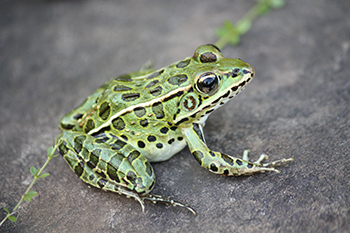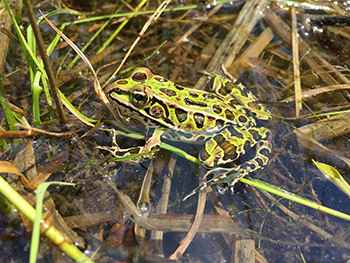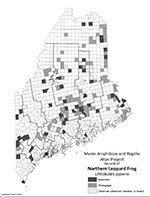Home → Fish & Wildlife → Wildlife → Species Information → Reptiles & Amphibians → Northern Leopard Frog
Northern Leopard Frog
Lithobates pipiens
On this page:

Photo: Trevor Persons
Distinguishing Characteristics

Photo: Trevor Persons
- Commonly confused with pickerel frog, with which it shares similar coloration and patterning
- Medium-sized, approximately 2 to 3.5 inches in length
- Usually green (sometimes brown) above with irregularly arranged rounded dark spots with thin light borders on back between prominent ridges (dorsolateral folds) along sides of back from behind eye to near groin
- Underside white to grayish-white
- Breeding call is an extended low snore with individual notes usually discernible, interspersed with short grunts and chuckles
Status and Distribution in Maine
- State Special Concern; Species of Greatest Conservation Need
- Common
- Western, central, eastern, and northern regions
Habitat
- Adults are semi-terrestrial, using wet fields, sedge meadows, or wet forested areas
- Breeds in shallow water of slow streams, ponds, or lakes
Diet
- Tadpoles eat algae, and adults eat a wide variety of invertebrates, especially beetles
Seasonal Changes
- Hibernate under rocks or in shallow self-made “pits” at the bottom of streams or ponds
Natural History Notes
- Breeds from May through late June
- Egg clutches may contain 2,000-4,000 eggs
- Adult frogs while on land obtain moisture by sitting on dew-covered plants or damp ground and absorbing water through skin in their groin area
Share Your Sighting
There is much still to learn about the distribution and ecology of Maine’s herpetofauna, and we encourage members of the public to share their photo-documented observations as part of the Maine Amphibian & Reptile Atlas Project (MARAP).
To see if a township still needs documentation of a species, consult this distribution map (PDF). If a township lacks a photo or specimen record, we want your observation!
There are two ways to share your observations:
Submit your reptile or amphibian observation online
No service? No problem. Click here to download the survey to your device while connected, then take offline to collect observations from anywhere. Tip: The survey works best on Google Chrome and Safari.
Or upload sightings to the iNaturalist citizen science project through their website at iNaturalist.org or mobile app.
- When submitting an observation through iNaturalist add a description of the location (and other noteworthy information) to the “notes” field. This serves as a check on the locations automatically generated by smartphone cameras, which may be imprecise if cell service or GPS coverage is weak.
Thank you for doing your part to help conserve Maine’s reptiles and amphibians.
